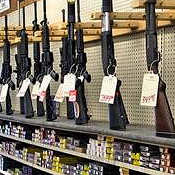 There has never been a seriously-advocated rational reason for the U.S., unlike most other countries, to have one export agency regulating exports of weapons and a separate export agency regulating exports of dual use items. A new regulation adopted by the Bureau of Industry and Security (“BIS”) last May, and which I hadn’t noticed at the time but which was pointed out today by an astute reader, is a perfect example of the confusion sown by this split personality approach to export regulation.
There has never been a seriously-advocated rational reason for the U.S., unlike most other countries, to have one export agency regulating exports of weapons and a separate export agency regulating exports of dual use items. A new regulation adopted by the Bureau of Industry and Security (“BIS”) last May, and which I hadn’t noticed at the time but which was pointed out today by an astute reader, is a perfect example of the confusion sown by this split personality approach to export regulation.
The regulation created a new, and frankly obtuse, ECCN designated as 0A919 which, to the extent any sense can be made of it, covers military items produced outside the United States which incorporate certain thermal imaging devices and which are “not subject to the International Traffic in Arms Regulations.” Don’t go rushing now to your copy of the ITAR to find a definition of items “subject to the ITAR,” because you won’t find it. The Export Administration Regulations (“EAR”) administered by BIS talks about “items subject to the EAR” but the ITAR at times focuses instead on what people are subject to its jurisdiction, particularly in respect to Part 129’s brokering regulations which intersect uncomfortably with the new ECCN.
Let’s now look at a specific example and see what happens. Consider a military vehicle which incorporates a thermal imaging camera controlled by BIS and which was manufactured outside the United States. If a U.S. person sought to export that vehicle from its country of manufacture to another country, that person (depending on the value of the vehicle and its export destinations) could be required to get permission from the Directorate of Defense Controls (“DDTC”) which regulates brokering in Part 129 of the ITAR. And given the new ECCN, that person might also require an export license from BIS (depending, of course, on the destination of the exported vehicle).
BIS tries unsuccessfully to avoid this overlapping jurisdiction with an awkwardly worded note to the new ECCN:
Brokering activities (as defined in 22 CFR 129.9) of military commodities that are subject to the ITAR are under the licensing jurisdiction of the Department of State.
That note doesn’t work because under part 129 all defense articles, irrespective of U.S. content, “are subject to the ITAR.” The brokering regulations in part 129 cover U.S. persons and foreign persons in the United States or otherwise subject to U.S. jurisdiction if they engage in brokering a defense article even if not one single component of that article was produced in the United States.
The note, and indeed the entire ECCN, only makes sense if whether something was subject to the ITAR depended on U.S. content in the same way that “subject to the EAR” under the EAR’s definition depends on the amount of U.S. content. And that’s apparently what somebody at BIS was thinking. If we had one export agency handling both dual use items and military items, this kind of basic confusion would be much less likely to occur.

 Posted by
Posted by  Category:
Category: 

 On Tuesday, the website of the Directorate of Defense Trade Controls announced that it had updated its “
On Tuesday, the website of the Directorate of Defense Trade Controls announced that it had updated its “ We
We  For reasons known only to the IT folks at the Directorate of Defense Trade Controls (“DDTC”), the agency’s electronic export licensing system (D-Trade) adopted the quirky, non-standard PureEdge Viewer as the software required to fill out and digitally sign export license applications forms rather than the industry standard (and widely installed) Adobe Acrobat. It’s probably safe to assume that no one had ever heard of PureEdge before it became a mandatory part of D-Trade.
For reasons known only to the IT folks at the Directorate of Defense Trade Controls (“DDTC”), the agency’s electronic export licensing system (D-Trade) adopted the quirky, non-standard PureEdge Viewer as the software required to fill out and digitally sign export license applications forms rather than the industry standard (and widely installed) Adobe Acrobat. It’s probably safe to assume that no one had ever heard of PureEdge before it became a mandatory part of D-Trade.


